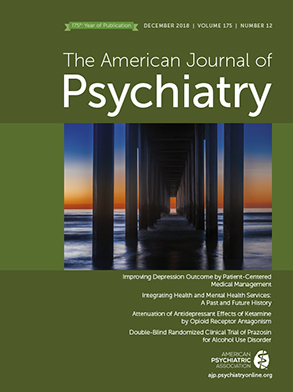Psychiatrists are now dealing with three “epidemics” that have a profound impact on society—opioid dependence, depression, and suicide. We desperately need new treatments for depression, and for suicidality, while also reducing opioid dependence and abuse. In the setting of this “triple crunch” and the frantic search for breakthrough treatments, low-dose intravenous ketamine has emerged as a potentially rapid-acting antidepressant that also quickly reduces suicidality. Could the universe be so cruel as to make it so that a treatment for one or two of the epidemics actually fuels the other? Thus, the article by Williams and colleagues (
1) in this issue has potentially broad clinical and social implications, as it raises questions about all three.
In this small-sample single-center crossover trial, these innovative Stanford researchers asked a simple but important question: Do the rapid antidepressant effects of ketamine depend on activation of opioid receptors? Specifically, can you block the antidepressant effect of ketamine by pretreatment with naltrexone, an opioid blocker? They asked this question in part because the other main pharmacological action of ketamine, N-methyl-d-aspartate (NMDA) receptor antagonism, has largely failed to emerge as the necessary mechanism of action for ketamine’s antidepressant effects. The answer seems clear from this trial, which was stopped early because the distinct answer emerged with only half the projected sample. Pretreating with naltrexone dramatically blocked the antidepressant effect of ketamine, but it did not block the dissociation that many subjects experience. That is, ketamine’s acute antidepressant effect appears to require opioid system activation. The succinct and logical conclusion from the research is that opioid receptors are necessary for ketamine’s acute antidepressant effect.
What does this mean, and what are the implications? First, this is a small-sample study, made smaller by the data safety decision rules set up before the trial, and the findings need to be tested for replication by others before final acceptance. But assuming the results are replicated, what can we conclude? First, we do not know which opioid receptors are the critical path. Either mu or kappa opioid receptors, or both, may be key. And, based on this single study, we cannot conclude that ketamine as an antidepressant is just another opioid, although the results would not be inconsistent with this conclusion. It may be that ketamine’s effects require combined opioid receptor activation and NMDA receptor antagonism. Or it is possible that other actions of ketamine lead to opioid receptor activation, or that those opioid receptors modulate yet a different system. Clearly, this study opens up several next steps and studies to address questions that are crucial to answer, particularly given the size, cost, importance, and urgency of the three ongoing epidemics.
But what about the three epidemics and ketamine? Should emergency departments that are considering using intravenous ketamine as an antisuicide measure pause, as they may now be making depressed patients opioid addicts? Many ketamine clinics are popping up around the country, sometimes without input from psychiatrists, and without plans for transitioning depressed patients back to other therapies. Are they nothing more than modern opium dens? Longer-term repeated use of intranasal esketamine is just beginning to be explored, although with promising initial success (
2). Does quick ketamine treatment with often-transient antidepressant improvement have an opportunity cost and stop patients from getting other known effective and long-term treatments?
While almost anything that resolves suicidality is helpful, it is important to remember that treatment-resistant depression is a chronic and recurring illness, and ketamine may or may not become a chronic treatment (
3). Our field should not stop appropriate ketamine research and use. But appropriate use means that ketamine should be given under a psychiatrist’s supervision and monitoring, and with plans to transition patients from ketamine to other medications or devices if the depression recurs.
We need also to keep in mind other underused treatments for depression and suicidality. Electroconvulsive therapy is still our most effective acute antidepressant, and innovations in technique are dramatically reducing the cognitive side effects (
4,
5). Transcranial magnetic stimulation has potential acute antisuicide effects when administered in accelerated doses (
6), and it can be used in a maintenance fashion, with the promise of reasonable durability (
7). Finally, cervical vagus nerve stimulation has remarkable long-term durability of effect in depressed patients who show an initial response (
8). With these other long-term options available, ketamine clinics that do not focus on accurate diagnosis, use proper symptom rating instruments, and discuss long-term treatment options are likely not in patients’ best interests.
Clearly, more work is needed to understand ketamine’s antidepressant effects and its mechanisms. In Greek mythology, several monsters had multiple heads. If you cut off one of the Hydra’s heads, it grew back, and sometimes more than one. We would hate to treat the depression and suicide epidemics by overusing ketamine, which might perhaps unintentionally grow the third head of opioid dependence. With these new findings, we should be cautious about widespread and repeated use of ketamine before further mechanistic testing has been performed to determine whether ketamine is merely another opioid in a novel form. If ketamine does indirectly activate opioid receptors, it could even have positive effects in approaching the opioid as well as the other epidemics. In any case, we need to better understand ketamine’s mode of action and how it should best be used and administered.

